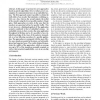251 search results - page 4 / 51 » Reducing the Knowledge Tracing Space |
FUZZIEEE
2007
IEEE
14 years 1 months ago
2007
IEEE
— DNA sequence basecalling is commonly regarded as a solved problem, despite significant error rates being reflected in inaccuracies in databases and genome annotations. This has...
ATVA
2006
Springer
13 years 11 months ago
2006
Springer
We present the implementation of the trace theory in a new model checking tool framework, POEM, that has a strong emphasis on Partial Order Methods. A tree structure is used to sto...
RT
2001
Springer
13 years 12 months ago
2001
Springer
Abstract. Photo-realistic rendering algorithms such as Monte Carlo ray tracing sample individual paths to compute images. Noise and aliasing artefacts are usually reduced by supers...
SEMWEB
2010
Springer
13 years 2 months ago
2010
Springer
Space and time have not received much attention on the Semantic Web so far. While their importance has been recognized recently, existing work reduces them to simple latitude-longi...
CEC
2003
IEEE
14 years 26 days ago
2003
IEEE
In this paper we present two new approaches based on genetic algorithms (GA) to reduce power consumption by communication buses in an embedded system. The first approach makes it ...

